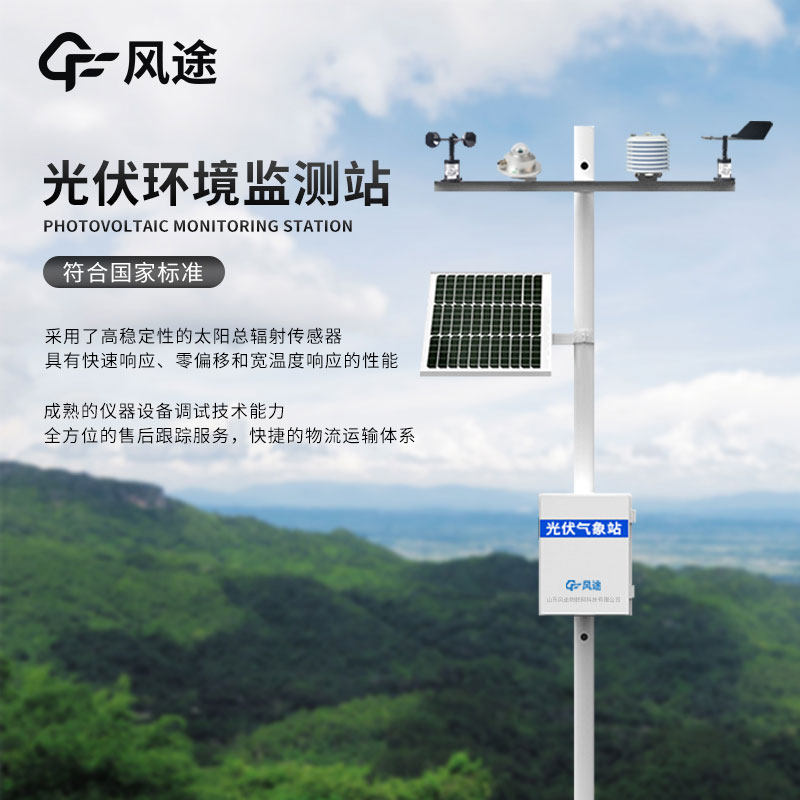Shandong Fengtu IOT Technology Co., Ltd
Sales Manager:Ms. Emily Wang
Cel,Whatsapp,Wechat:+86 15898932201
Email:info@fengtutec.com
Add:No. 155 Optoelectronic Industry Accelerator, Gaoxin District, Weifang, Shandong, China

Sales Manager:Ms. Emily Wang
Cel,Whatsapp,Wechat:+86 15898932201
Email:info@fengtutec.com
Add:No. 155 Optoelectronic Industry Accelerator, Gaoxin District, Weifang, Shandong, China
time:2024-10-30 09:03:23 source:Weather Station viewed:531 time
Photovoltaic weather stations are crucial for large-scale ground photovoltaic power stations. In terms of photovoltaic radiation monitoring, they can determine how much photovoltaic radiation is incident on the surface of photovoltaic modules, which is significant for assessing the potential for power generation and predicting power output, providing basic data for the operation and management of power stations. In the assessment of power station performance and performance, power station owners rely on meteorological stations and data collectors to measure project performance, and the data can reflect the power generation efficiency under different environments, helping owners to know whether the power station meets the standards and whether maintenance and optimization are needed. Although the implementation of the IEC61724-1 standard in 2017 has pain points, such as the time-consuming installation of a large number of devices, the high cost and complex logistics of traditional Photovoltaic weather stations and distributed measurement sensor communication connections, the collection of distributed data is essential for connecting data that represents the efficiency of the system, which is related to the performance assessment of the power station. Photovoltaic weather station systems that incorporate distributed monitoring concepts in their design can avoid high costs and complicated work while meeting standard requirements, showing that a good Photovoltaic weather station system can optimize the monitoring process, reduce costs, and make power station operations more efficient and economical.
I recommend the Photovoltaic weather station model FT-FGF9.
It has comprehensive functions and can accurately measure meteorological parameters related to photovoltaic power generation, such as ambient temperature, humidity, dew point temperature, wind speed, wind direction, atmospheric pressure, module temperature, and horizontal total radiation. It can also record and analyze the cumulative data of horizontal total radiation on a daily, monthly, and annual basis, which is of great significance for the operation assessment and resource planning of photovoltaic power stations. The measurement accuracy is high, with stable performance of the total solar radiation sensor and high measurement accuracy of other sensors such as ambient temperature and wind speed. It has strong adaptability, a wide range of working and storage temperature, and can work stably under extreme climate conditions. It has an IP65 protection level and can withstand harsh outdoor environments. It has flexible communication options, including WiFi, GPRS, RS485, and wireless point-to-point communication modes, and supports various ways of data reception, making it convenient to obtain and analyze data. It is easy to install and maintain, with a variety of fixed brackets available for different carrying forms, and the manufacturer has rich experience and after-sales support, providing professional guidance and technical support. It also complies with national standards, meets the data reporting requirements of photovoltaic power stations, and follows multiple international, national, and industry standards in design and implementation, ensuring the safe and efficient operation of photovoltaic power stations.

Soil moisture monitor is an instrument for measuring soil moisture and temperature, which is usually used in agriculture, forestry, geology and other fields. This instrument can automatically monitor the moisture content and temperature of the soil and transmit the data to a computer or mobile phone...
Atmospheric environment monitoring sensors, as an important tool for monitoring physical and chemical parameters in the atmospheric environment, function by collecting real-time data on temperature, humidity, barometric pressure, wind speed, wind direction, and air quality. These sensors have a wide...
Soil moisture monitoring is crucial for agricultural production, water resource management, flood warning and drought assessment. Soil moisture research has been carried out at home and abroad.For example, in the mid-to-high altitude areas of Switzerland, the SOMOMOUNT network has been established t...
ambient weather soil moisture sensor can measure the moisture content in the soil, which is mostly used in agricultural crop planting to monitor whether the crop is short of water....